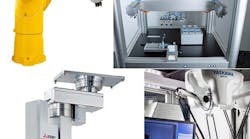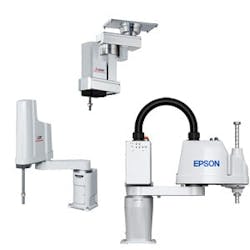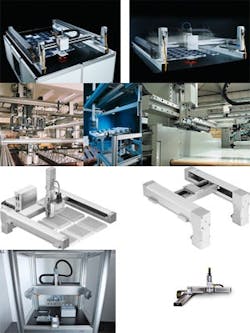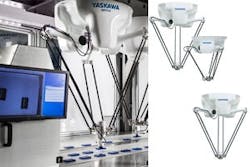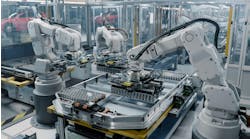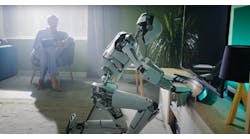When designing an automation project that involves moving an object from place to place or some repetitive motion function, it may benefit the project to include robots into the system. Choosing the correct type of robot affects the cost and success rate of the design. Simple applications use a programmed set of motions that are always constant. Adding a machine-vision system or a set of presence-sensing devices that interface with the robot control system allows adaptive motions that can change the actual positioning motions.
Robot vendors can assist in selecting a system that provides all the required positioning functions needed. A large number of videos are available on the Internet showing the different robot systems in motion. Keep in mind when watching these videos, if the video is a production from the manufacturer, the robots are usually designed to operate at the limits of their performance. In actual use for real production, it may be impossible or impractical to run the robot at its limits of performance in a constant manner.
Figure 1: When most people think of an industrial robot, they visualize some version of an articulated robot.
(Source: Universal Robots, Staubli)
Many robot manufacturers provide modeling and simulation software to assist in selecting the best solution for the required tasks. The acronym “LOSTPED” assists in defining the information required to develop a robot specification. Load, orientation, speed, travel, precision, environment and duty cycle are the data points required to properly size and design a robot system or any motion control application.
There are several general robot types to choose from, each having some additional functions or modifications to customize the application.
When most people think of an industrial robot, they visualize some version of an articulated robot (Figure 1). This type of robot is prevalent in television commercials and industrial videos. The definition for an articulated robot is somewhat loose but is described as having a solidly mounted base and having between four axes and six axes, although as few as two axes and as many as 10 axes are available. Additionally, the end of arm tooling (EOAT) can provide more movement options. A standard feature of articulated robots is their ability to work in a three-dimensional space, or work envelope. The maximum workspace envelope resembles a sphere, and the common definition of a point in space uses the polar coordinate system.
Figure 2: Selective compliance assembly robot arm (SCARA) robots have a solidly mounted base in a fixed position.
(Sources: Epson Robots, Mitsubishi Robotics)
Because articulated robots have such a large work envelope and can put the EOAT in an almost infinite number of angles on an almost infinite number of planes, common uses for this type of robot are quite varied. Welding applications, using any of the welding techniques available, are more consistent and repeatable than a human can accomplish. When the workpiece is in a fixed position, the welding tip is precisely positioned for the optimum distance, angle and speed. Precise, repeatable inspections using 3D lasers and machine vision are possible even if the workpiece is not perpendicular to the robot base. Other applications include painting, drilling, tapping, cutting, pick-and-place, material handling, packaging and assembly.
Of the robot types discussed here, articulated robots are typically on the higher end of pricing. Programming for simple motions can often be accomplished by directly teaching the various points and actions. More complicated positioning requires writing code for the controller. Having on-site staff available that can modify or fine tune positions will be a benefit.
Selective compliance assembly robot arm (SCARA) robots have a solidly mounted base in a fixed position (Figure 2). The arm is fixed in the z-axis with rotational motion in the xy-axis. The arm has an additional xy-axis joint midway along its length. A linear actuator at the end of the arm provides z-axis motion at 90° to the base’s mounting plane. An additional theta axis is supplied to the linear actuator to bring the total axis count to four. In many ways, the SCARA robot mimics the movement of a human arm. The maximum workspace envelope resembles a partial cylinder.
Figure 3: Cartesian robots make use of a framework to distribute the weight of the load.
(Sources: Parker Motion, Festo)
In operation, a SCARA robot arm can be operated at high speed while maintaining high-precision positioning. If the operational planes are parallel, process-to-process material-handling applications and product assembly are often accomplished using a SCARA robot arm. Using displacement lasers at the tool end can provide high-speed coordinate-measuring-machine (CMM) functions on an assembly line. A machine vision system coupled with a SCARA robot allows sophisticated non-contact inspections. Lasers, plasma cutters and routers mounted to the tooling end of the arm enable precise etching, cutting and milling operations.
The weight carried by a SCARA robot places radial loads on the rotational joints. The bearings must be robust enough to perform adequately for the desired lifetime of the project. The momentum of the load must not exceed the motor’s ability to slow and stop arm movement.
Cartesian, or gantry, robots can typically manipulate much heavier loads than articulated or SCARA robots, often at a lower cost. Cartesian robots make use of a framework to distribute the weight of the load (Figure 3). Linear operation in x, y and z axes, cartesian robots are limited to movement within the frame. However, the length of the frame can be measured in tens or hundreds of feet or meters. The framework may be standard or semi-standard linear slides and ball screws allowing the cartesian robot to be modified or repurposed when necessary. The work envelope resembles a rectangle, and positioning is defined using the cartesian coordinate system.
Figure 4: Unlike arm-style machines, a delta robot can move in 360° circles within its work envelope.
(Source: Yaskawa Motoman)
Often used as product pick-and-place devices, cartesian robots may also be used to apply sealant, control routers, lasers and plasma cutters or any motion that fits within the robot’s work envelope.
Delta robots use three sets of parallel arms and rotary or linear actuators (Figure 4). Applying force to the actuators cause the end effector to travel in an x, y and z axis with no rotation. Originally developed as a pick-and-place device for lightweight loads, additional uses include 3D printing, surgery and assembly operations. The delta robot uses lightweight arms with little inertia and can be amazingly fast. Unlike arm-style machines, a delta robot can move in 360° circles within its work envelope.
ALSO READ: Programming languages pave the way for the reign of robots

Leaders relevant to this article:
